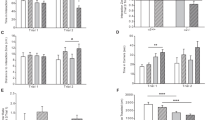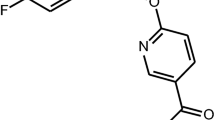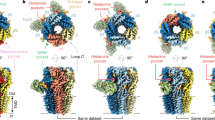Abstract
Aim:
The continuous presence of an agonist drives its receptor into a refractory state, termed desensitization. In this study, we tested the hypothesis that a competitive antagonist, SR95531, could facilitate the recovery of α1β2γ2 GABAA receptor from functional desensitization.
Methods:
α1β2γ2 GABAA receptors were expressed in Xenopus oocytes. GABA-evoked currents were recorded using two-electrode voltage-clamp technique. Drugs were applied through perfusion.
Results:
Long application of GABA (100 μmol/L) evoked a large peak current followed by a small amplitude steady-state current (desensitization). Co-application of SR95531 during the desensitization caused a larger rebound of GABA current after removal of SR95531. Furthermore, application of SR95531 after removal of GABA increased the rate of receptor recovery from desensitization, and the recovery time constant was decreased from 59±3.2 s to 33±1.6 s. SR95531-facilitated receptor recovery from desensitization was dependent on the perfusion duration of SR95531. It was also dependent on the concentration of SR95531, and the curve fitting with Hill equation revealed two potency components, which were similar to the two potency components in inhibition of the steady-state current by SR95531. Bicuculline caused similar facilitation of desensitization recovery.
Conclusion:
SR95531 facilitates α1β2γ2 GABAA receptor recovery from desensitization, possibly through two mechanisms: binding to the desensitized receptor and converting it to the non-desensitized state, and binding to the resting state receptor and preventing re-desensitization.
Similar content being viewed by others
Log in or create a free account to read this content
Gain free access to this article, as well as selected content from this journal and more on nature.com
or
References
Lester H, Dibas M, Dahan D, Leite J, Dougherty D . Cys-loop receptors: new twists and turns. Trends Neurosci 2004; 27: 329–36.
Sine S, Engel A . Recent advances in Cys-loop receptor structure and function. Nature 2006; 440: 448–55.
Albuquerque E, Pereira E, Alkondon M, Rogers S . Mammalian nicotinic acetylcholine receptors: from structure to function. Physiol Rev 2009; 89: 73–120.
Lummis S . 5-HT3 receptors. J Biol Chem 2012; 287: 40239–45.
Olsen R, Sieghart W . GABAA receptors: subtypes provide diversity of function and pharmacology. Neuropharmacology 2009; 56: 273–84.
Lynch J . Native glycine receptor subtypes and their physiological roles. Neuropharmacology 2009; 56: 303–9.
Davies P, Wang W, Hales T, Kirkness E . A novel class of ligand-gated ion channel is activated by Zn2+. J Biol Chem 2003; 278: 712–7.
Althoff T, Hibbs R, Banerjee S, Gouaux E . X-ray structures of GluCl in apo states reveal a gating mechanism of Cys-loop receptors. Nature 2014; 512: 333–7.
Beg A, Jorgensen E . EXP-1 is an excitatory GABA-gated cation channel. Nat Neurosci 2003; 6: 1145–52.
Zheng Y, Hirschberg B, Yuan J, Wang A, Hunt D, Ludmerer S, et al. Identification of two novel Drosophila melanogaster histamine-gated chloride channel subunits expressed in the eye. J Biol Chem 2002; 277: 2000–5.
Ranganathan R, Cannon S, Horvitz H . MOD-1 is a serotonin-gated chloride channel that modulates locomotory behaviour in C elegans. Nature 2000; 408: 470–5.
Bocquet N, Nury H, Baaden M, Poupon C, Changeux J, Delarue M, et al. X-ray structure of a pentameric ligand-gated ion channel in an apparently open conformation. Nature 2009; 457: 111–4.
Hilf R, Dutzler R . Structure of a potentially open state of a proton-activated pentameric ligand-gated ion channel. Nature 2009; 457: 115–9.
Chang Y, Wu W, Zhang J, Huang Y . Allosteric activation mechanism of the cys-loop receptors. Acta Pharmacol Sin 2009; 30: 663–72.
Colquhoun D . Binding, gating, affinity, and efficacy: the interpretation of structure-activity relationships for agonists and of the effects of mutating receptors. Br J Pharmacol 1998; 125: 923–48.
del Castillo J, Katz B . Interaction at end-plate receptors between different choline derivatives. Proc R Soc Lond B Biol Sci 1957; 146: 369–81.
Katz B, Thesleff S . A study of the desensitization produced by acetylcholine at the motor end-plate. J Physiol 1957; 138: 63–80.
Giniatullin R, Nistri A, Yakel J . Desensitization of nicotinic ACh receptors: shaping cholinergic signaling. Trends Neurosci 2005; 28: 371–8.
Jones M, Westbrook G . Desensitized states prolong GABAA channel responses to brief agonist pulses. Neuron 1995; 15: 181–91.
Chen Y, Reilly K, Chang Y . Evolutionarily conserved allosteric network in the cys-loop family of ligand-gated ion channels revealed by statistical covariance analyses. J Biol Chem 2006; 281: 18184–92.
Changeux J, Edelstein S . Allosteric receptors after 30 years. Neuron 1998; 21: 959–80.
Chang Y, Weiss D . Channel opening locks agonist onto the GABAC receptor. Nat Neurosci 1999; 2: 219–25.
Chang Y, Weiss D . Site-specific fluorescence reveals distinct structural changes with GABA receptor activation and antagonism. Nat Neurosci 2002; 5: 1163–8.
Chang Y, Ghansah E, Chen Y, Ye J, Weiss D . Desensitization mechanism of GABA receptor revealed by single oocyte binding and receptor function. J Neurosci 2002; 22: 7982–90.
Scheller M, Forman S . Coupled and uncoupled gating and desensitization effects by pore domain mutations in GABAA receptors. J Neurosci 2002; 22: 8411–21.
Bartrup J, Newberry N . Electrophysiological consequences of ligand binding to the desensitized 5-HT3 receptor in mammalian NG108-15 cells. J Physiol 1996; 490: 679–90.
Chang Y, Weiss D . Allosteric activation mechanism of the α1β2γ2 γ-aminobutyric acid type A receptor revealed by mutation of the conserved M2 leucine. Biophys J 1999; 77: 2542–51.
Ueno S, Bracamontes J, Zorumski C, Weiss D, Steinbach J . Bicuculline and gabazine are allosteric inhibitors of channel opening of the GABAA receptor. J Neurosci 1997; 17: 625–34.
Lüddens H, Korpi E . GABA antagonists differentiate between recombinant GABAA/benzodiazepine receptor subtypes. J Neurosci 1995; 15: 6957–62.
Nicolai C, Sachs F . Solving ion channel kinetics with the QuB software. Biophys Rev Lett 2013; 8: 1–21.
Amin J, Weiss DS . GABAA receptor needs two homologous domains of the b subunit for activation by GABA, but not by pentobarbital. Nature 1993; 366: 565–9.
Gielen M, Thomas P, Smart T . The desensitization gate of inhibitory Cys-loop receptors. Nat Commun 2015; 6: 6829.
Wagner D, Czajkowski C . Structure and dynamics of the GABA binding pocket: a narrowing cleft that constricts during activation. J Neurosci 2001; 21: 67–74.
Hansen S, Sulzenbacher G, Huxford T, Marchot P, Taylor P, Bourne Y . Structures of Aplysia AChBP complexes with nicotinic agonists and antagonists reveal distinctive binding interfaces and conformations. EMBO J 2005; 24: 3635–46.
Huang X, Chen H, Michelsen K, Schneider S, Shaffer P . Crystal structure of human glycine receptor-α3 bound to antagonist strychnine. Nature 2015; 526: 277–80.
Du J, Lu W, Wu S, Cheng Y, Gouaux E . Glycine receptor mechanism elucidated by electron cryo-microscopy. Nature 2015; 526: 224–9.
Newell J, Czajkowski C . The GABAA receptor α1 subunit Pro174–Asp191 segment is involved in GABA binding and channel gating. J Biol Chem 2003; 278: 13166–72.
Boileau A, Glen Newell J, Czajkowski C . GABAA receptor β2 Tyr97 and Leu99 line the GABA-binding site: Insights into mechanisms of agonist and antagonist actions. J Biol Chem 2002; 277: 2931–7.
Newell J, McDevitt R, Czajkowski C . Mutation of glutamate 155 of the GABAA receptor β2 subunit produces a spontaneously open channel: a trigger for channel activation. J Neurosci 2004; 24: 11226–35.
Holden J, Czajkowski C . Different residues in the GABAA receptor α1T60-α1K70 region mediate GABA and SR-95531 actions. J Biol Chem 2002; 277: 18785–92.
Kloda J, Czajkowski C . Agonist-, antagonist-, and benzodiazepine-Induced structural changes in the α1Met113-Leu132 region of the GABAA receptor. Mol Pharmacol 2007; 71: 483–93.
Gay E, Giniatullin R, Skorinkin A, Yakel J . Aromatic residues at position 55 of rat α7 nicotinic acetylcholine receptors are critical for maintaining rapid desensitization. J Physiol 2008; 586: 1105–15.
Lape R, Colquhoun D, Sivilotti L . On the nature of partial agonism in the nicotinic receptor superfamily. Nature 2008; 454: 722–7.
Yu R, Hurdiss E, Greiner T, Lape R, Sivilotti L, Biggin P . Agonist and antagonist binding in human glycine receptors. Biochemistry 2014; 53: 6041–51.
Hibbs R, Gouaux E . Principles of activation and permeation in an anion-selective Cys-loop receptor. Nature 2011; 474: 54–60.
Millar P, Aricescu A . Crystal structure of a human GABAA receptor. Nature 2014; 512: 270–5.
Acknowledgements
We thank Dr Alan GIBSON for his help in proofreading the manuscript. This work was supported by the National Institute of General Medical Sciences (R01GM085237), and Barrow Neurological Foundation (to Yong-chang CHANG).
Author information
Authors and Affiliations
Corresponding author
Additional information
Supplementary Figures are available at the Acta Pharmacologica Sinica's website.
Supplementary information
Supplementary Figure S1
The amplitude of the rebound current by SR95531 application is concentration dependent. (GIF 8 kb)
Supplementary Figure S2
Conformational difference between agonist-bound and antagonist-bound structures in the orthosteric binding site. (GIF 83 kb)
Supplementary Figure S3
Impact of cysteine mutations on the Ki values of SR95531 and the EC50 values of GABA for recombinant GABAA receptors. (GIF 9 kb)
Supplementary Figure S4
Facilitated recovery from desensitization by a competitive antagonist (3-APA) in the human ρ1 GABA receptor. (GIF 4 kb)
PowerPoint slides
Rights and permissions
About this article
Cite this article
Xu, Xj., Roberts, D., Zhu, Gn. et al. Competitive antagonists facilitate the recovery from desensitization of α1β2γ2 GABAA receptors expressed in Xenopus oocytes. Acta Pharmacol Sin 37, 1020–1030 (2016). https://doi.org/10.1038/aps.2016.50
Received:
Accepted:
Published:
Issue date:
DOI: https://doi.org/10.1038/aps.2016.50
Keywords
This article is cited by
-
The Influence of AA29504 on GABAA Receptor Ligand Binding Properties and Its Implications on Subtype Selectivity
Neurochemical Research (2022)



